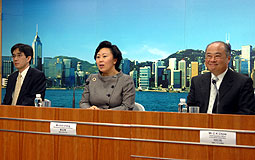
|
| High-speed network: Deputy Secretary for Transport & Housing Philip Yung, Secretary Eva Cheng and MTRC Chief Executive Officer CK Chow discuss the Shatin-to-Central Link and the Kwun Tong Line Extension at a press conference. |
Construction is due to start in 2010 for both the 17km Shatin-to-Central Link and the Kwun Tong Line Extension from Yau Ma Tei Station to Whampoa, Secretary for Transport & Housing Eva Cheng says.
The Executive Council has given its nod to the MTR Corporation to proceed with further planning of the two projects.
At a press conference today, Ms Cheng said the link will carry about 1 million passengers a day in 2021, and generate $4 billion in annual economic benefits in terms of travel-time savings. The Kwun Tong extension's daily patronage is estimated to be 180,000 by 2016.
The link will have nine stations - Tai Wai, Diamond Hill, Kai Tak, To Kwa Wan, Ma Tau Wai, Homantin, Hung Hom, Exhibition and Admiralty - linking the Northeast New Territories and Hong Kong Island via Southeast Kowloon. It will serve a population of 300,000 residents and 280,000 employees.
Phased completion
Ms Cheng said in considering the future railway service demands - and the interfaces between the link and various development plans and infrastructure projects along its alignment - the Government intends to have the link completed in phases. The Tai Wai to Hung Hom section is expected to be ready by 2015 and the cross-harbour section by 2019.
The project is expected to provide essential support for the proposed new commercial and residential developments and leisure facilities planned at Kai Tak, including the multi-purpose stadium complex and the metro park.
Old districts, like To Kwa Wan and Kowloon City, will see a surge of redevelopment opportunities with the improved public-transport infrastructure. The new rail will create 11,000 jobs during construction and another 9,600 during its operation.
"The link will connect several existing railway lines and create two distinctive east-west and north-south railway corridors," Ms Cheng noted.
Rail corridors
From east to west, it will link up the Ma On Shan Line, the Kowloon Southern Link and the West Rail Line, allowing commuters to travel directly from Ma On Shan to Tuen Mun in 69 minutes.
The north-south corridor will be formed by extending the existing East Rail Line across the harbour. Passengers will be able to travel in about 50 minutes from Lo Wu or Lok Ma Chau to the heart of Hong Kong Island without switching trains.
On interchanges with other railway lines, six stations - Tai Wai, Diamond Hill, Homantin, Hung Hom, Exhibition and Admiralty - will provide passengers with either an inter-platform or inter-level interchange for other lines.
Ms Cheng said Tai Wai and Admiralty will be the two key interchange stations. The Ma On Shan Line, East Rail Line and the link will converge at Tai Wai, while Admiralty will allow the link's passengers to change trains for the Tsuen Wan Line, the Island Line and the future South Island Line.
The link can effectively redistribute the passenger flow, easing pressure on existing railway lines in urban Kowloon and on Hong Kong Island. It will also help relieve reliance on road-based public transport and reduce traffic congestion and environmental nuisance.
Concession approach
"After careful consideration of both the operational and financial implications, the Government has decided to adopt a concession approach to fund the estimated construction cost of $37.4 billion," she said.
"Upon completion, the MTRC will be granted a service concession for the subsequent operation and pay the Government annually for the concession. Property-development rights are not included in the concession."
The MTRC will pay about $91.8 billion in concessions over 50 years, Ms Cheng added.
The link's train depot will be built at Diamond Hill. An environmental impact assessment will be conducted and suitable mitigation measures adopted to minimise impact on the surroundings.
Ms Cheng said as building a station at Tsz Wan Shan is technically difficult and unsafe, and could create a noise-pollution problem, the Government will consider increasing pedestrian facilities and reviewing minibus services to improve the transport services and connectivity with the link.
On earlier proposals to build a Central South station at the Zoological & Botanical Gardens or west of Wyndham Street, she said the two locations have been ruled out. The Government will reconsider whether to construct the station after its headquarters in Central are relocated to the Tamar site.
Explaining the later completion of the link's cross-harbour section, Deputy Secretary for Transport & Housing (Transport) Philip Yung said the section must tie in with other major projects on the Island side, including the Central-Wan Chai Bypass and Wan Chai Development Phase II which are still in planning stages.
Whampoa extension
The Kwun Tong Line Extension is due for completion by 2015 to serve the 140,000 residents in Whampoa and Homantin and to bring about $400 million in annual economic benefits.
Passengers from Whampoa will be able to reach Mong Kok in five minutes - down from the present 25 minutes by road-based transport during rush hours. Homantin Station will be an integrated interchange station for commuters to change to other lines.
"The extension will be implemented as an MTR project under an ownership approach. Its construction will cost $4.2 billion and the Government will discuss with the MTRC how the funding gap of $2.2 billion should be bridged," Ms Cheng said.
Welcoming the Executive Council's decision, MTRC Chief Executive Officer CK Chow said Hong Kong will be linked by rail networks in all directions when the two projects are in place. He added the MTRC will discuss details with the Government, and the design and planning work would start soon after the Legislative Council approves the funding.
On the Kwun Tong extension, Mr Chow suggested the property-development rights be used to bridge the funding gap.
The Government will consult the public on both projects to formulate a first-rate and efficient railway scheme that will best serve Hong Kong.
|